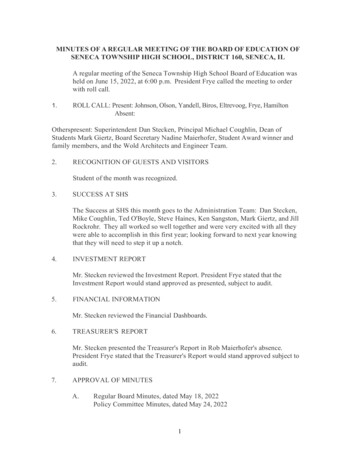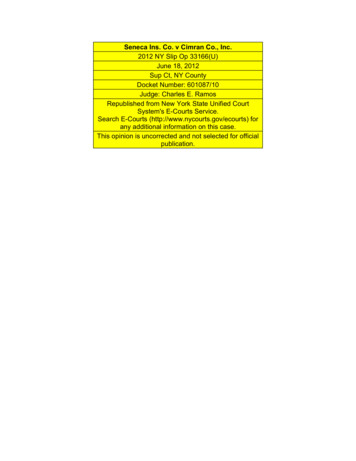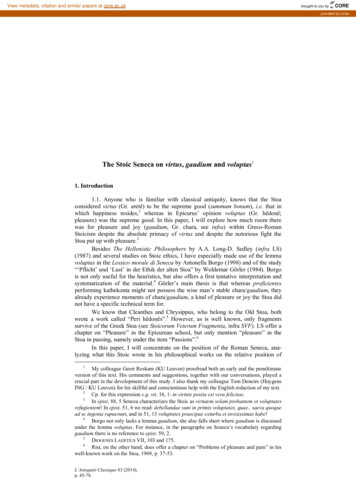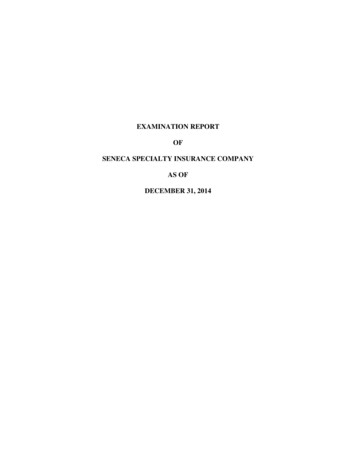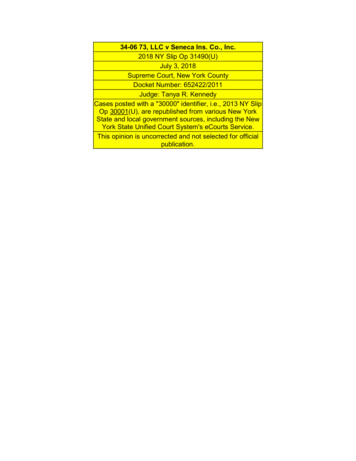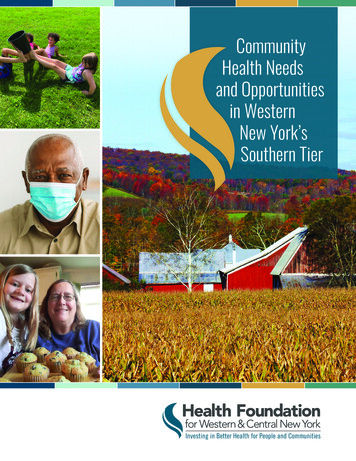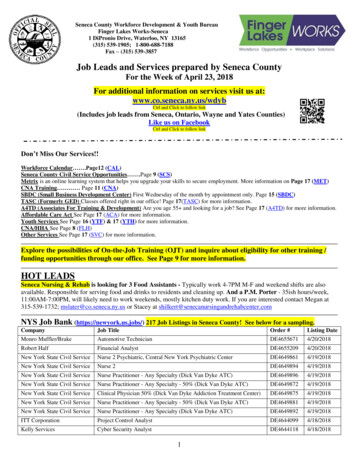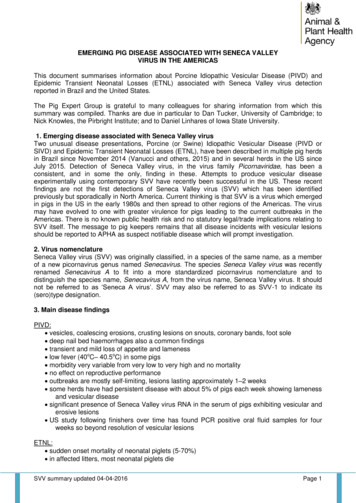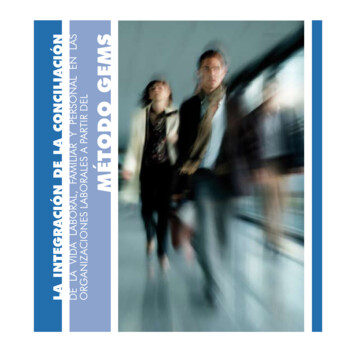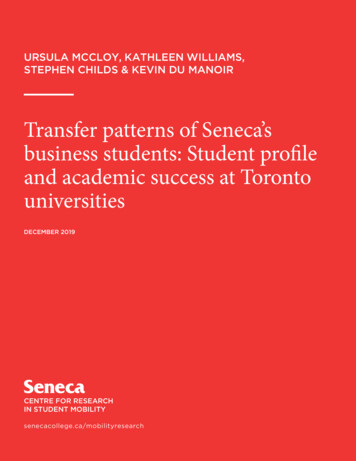
Transcription
URSULA MCCLOY, KATHLEEN WILLIAMS,STEPHEN CHILDS & KEVIN DU MANOIRTransfer patterns of Seneca’sbusiness students: Student profileand academic success at TorontouniversitiesDECEMBER 2019CENTRE FOR RESEARCHIN STUDENT MOBILITYsenecacollege.ca/mobilityresearch
Transfer patterns of Seneca’s business students: Student profile and academic success at Toronto universitiesList of ContactsURSULA MCCLOYDirector, Centre for Research in Student MobilitySENECA COLLEGEursula.mccloy@senecacollege.caKATHLEEN WILLIAMSResearch Analyst, Centre for Research in Student MobilitySENECA COLLEGEkate.williams@senecacollege.caSTEPHEN CHILDSSenior Institutional Analyst, Surveys and Special ProjectsOffice of Institutional Planning and AnalysisYORK UNIVERSITYsechilds@yorku.caKEVIN DU MANOIRSenior Admission Data AnalystUndergraduate Admissions and RecruitmentRYERSON UNIVERSITYkevin.dumanoir@ryerson.ca1
Transfer patterns of Seneca’s business students: Student profile and academic success at Toronto universitiesAcknowledgementsWe’d like to thank our partners in Ryerson’s Registrar’s Office, including Ron Ferguson,Barbara Cecchetto, and Charmaine Hack. Particular thanks to Ron Ferguson for severalinformative discussions and for leading the initiative at Ryerson. At York, Richard Smith,Director of York’s Office of Institutional Analysis and Planning, is thanked for leading theinitiative at York University.Paula Green, administrator of the York Seneca Partnership and Victoria Baker, Manager ofSeneca’s Degree and Credit Transfer Office (DCTO) are thanked for providing expertise ontransfer pathways, and reviewing the report. Victoria Baker also shared data on behalf of theDCTO. Henry Decock, Associate VP, Academic Partnerships, and Karen Murkar, Chair, Schoolof Accounting & Financial Services at Seneca, are thanked for their advisement throughoutthe project and their review of the final report.A particular thanks go to a variety of data providers across Seneca, including StevenBudinszky, Robert Lerit, Daniel Smith, Susan LaPoint, Paul Armstrong, and Limin Chen forcontributing to the updating of our linked Seneca dataset. Pre-2015, Mustafizur Rahman, JohnMeskes, and Michael Cunningham of Seneca’s Information Technology Services Departmentsupported data extraction from Seneca’s student information system.Dilys Lehman is thanked for editing the final report, as well as Matthew Duncan for the reportlayout.This project was funded by the Ontario Council on Articulation and Transfer.2
Transfer patterns of Seneca’s business students: Student profile and academic success at Toronto universitiesTable of ContentsList of Contacts . 1Acknowledgements . 2Executive Summary . 7Introduction. 11Literature Review. 12College to University . 12University to College . 13Transfer Agreements and Policies for Seneca Business Students . 14Methodology . 17Results . 22Descriptive Analysis . 22Pathway Analysis . 43Regression Results . 54Discussion and Conclusion . 70References . 73Appendix A: Program and Faculty Groupings . 74Appendix B. Regression Model-Building . 76Appendix C: Reading and Math Assessment Scores . 773
Transfer patterns of Seneca’s business students: Student profile and academic success at Toronto universitiesTable of FiguresFigure 1. Data sources included in Seneca’s linked student-level dataset . 18Figure 2. Number of transfers by pathway. 23Figure 3. Percentage of students at college entry aspiring to attend university after college graduation,by transfer pathway . 26Figure 4. DCTO use among study population by transfer pathway and graduation status prior to transfer. 26Figure 5. Seneca reading comprehension assessment scores upon Seneca entry, by transfer pathway . 28Figure 6. Grades at sending institution prior to transfer, by transfer pathway and graduation status . 30Figure 7. Proportion of Seneca business students who transferred to York or Ryerson by gender, age,and status in Canada at Seneca entry . 31Figure 8. Proportion of Seneca business students who transferred to York or Ryerson by Seneca firstbusiness program area and credential . 31Figure 9. Proportion of Seneca business students who transferred to York or Ryerson by Seneca-entryassessment scores . 32Figure 10. Grades at the receiving institution after transfer by pathway and graduation status . 39Figure 11. Academic outcomes at Ryerson after transfer from Seneca, by Seneca GPA . 41Figure 12. Academic outcomes at York after transfer from Seneca, by Seneca GPA. 41Figure 13. Academic outcomes at Seneca after transfer from York, by York GPA. 42Figure 14. Academic outcomes at Seneca after transfer from Ryerson, by Ryerson GPA . 424
Transfer patterns of Seneca’s business students: Student profile and academic success at Toronto universitiesList of TablesTable 1. York University’s block transfer credit pathways by Seneca program/terms completed . 15Table 2. Ryerson admission requirements for transfer from Seneca . 16Table 3. Accuplacer proficiency levels . 20Table 4. Grading schemes at York, Ryerson and Seneca . 20Table 5. Socio-demographic characteristics of students by transfer pathway . 24Table 6. Top reasons for choosing Seneca by transfer pathway . 25Table 7. High school academic background by transfer pathway and graduation status prior to transfer. 27Table 8. Algebra and arithmetic assessment testing results by transfer pathway . 29Table 9. Proportion of Seneca business students who transferred to York or Ryerson by selectedstudent characteristics . 33Table 10. Amount of total transfer credit provided to Seneca business students transferring to York, bycredits earned at Seneca and graduation status prior to transfer . 34Table 11. Amount of total credit provided to Seneca business students transferring to Ryerson, by creditsearned at Seneca and graduation status prior to transfer . 34Table 12. Highest credential enrolled in at York and Ryerson by pathway, pre- and post-transfer fromSeneca . 35Table 13. Seneca business credential of entry by transfer pathway and graduation status prior to transfer. 35Table 14. York program of entry by transfer pathway . 36Table 15. Ryerson program of entry by transfer pathway . 37Table 16. Seneca program area of entry by transfer pathway . 38Table 17. Enrollment status one year after transfer by pathway and graduation status at the sendinginstitution . 39Table 18. Enrollment status two years after transfer by pathway and graduation status at the sendinginstitution .40Table 19. Academic outcomes at university for Seneca transfer students by estimated transfer creditreceived . 43Table 20. Number of Seneca transfers by program for Ryerson’s direct entry and degree completionpathways, graduates of three-year business administration diplomas . 44Table 21. Sending and receiving GPA of Seneca transfers in Ryerson’s business direct-entry and degreecompletion pathways, graduates of Seneca’s three-year business diplomas . 45Table 22. Graduation and retention rate of Seneca transfers in Ryerson’s business direct-entry anddegree completion pathways, graduates of Seneca’s three-year business diplomas . 46Table 23. Number of Seneca business graduates who transferred to York business and related programs,by program area. 47Table 24. Sending and receiving GPA of Seneca transfers to York’s business and related programs,graduates of Seneca’s business programs . 485
Transfer patterns of Seneca’s business students: Student profile and academic success at Toronto universitiesTable 25. Graduation and retention rates of Seneca transfers to York’s business and related degrees,graduates of Seneca’s business credentials . 48Table 26. Graduation and retention rate of Seneca transfers to York's Bachelor of Commerce, graduatesof Seneca’s two- and three-year business diplomas . 49Table 27. Pathways into Seneca's commerce degrees from university (York and Ryerson combined) . 50Table 28. Academic performance pre- and post-transfer to a Seneca business degree program fromuniversity (York/Ryerson) . 50Table 29. Graduation and retention rate of university transfer students to Seneca's business degreeprograms by last program at university compared to Seneca non-transfer students whose first programwas a Seneca business degree . 51Table 30. Pathways to Seneca business graduate certificate programs by university and universityprogram area . 52Table 31. Academic performance of students pre- and post-transfer to a Seneca business graduatecertificate program by transfer pathway . 53Table 32. First-year graduation rate for students transferring from York/Ryerson to Seneca's businessgraduate certificate programs . 54Table 33. Regression results: Propensity of Seneca students to transfer to university . 56Table 34. Regression results: Grades at Seneca for students transferring from York/Ryerson and nontransfer Seneca students . 58Table 35. Regression results: Odds of graduating on time at Seneca for students transferring fromYork/Ryerson and non-transfer Seneca students .60Table 36. Regression results: Grades at Seneca for students transferring from York/Ryerson . 62Table 37. Regression results: Odds of graduating on time at Seneca for students transferring fromYork/Ryerson . 65Table 38: Regression results: Odds of achieving a B average or above at university for studentstransferring from Seneca to York/Ryerson . 66Table 39. Regression results: Odds of first-year retention at university for students transferring fromSeneca to York/Ryerson. 68Table 40. Regression results: Odds of graduation within two years after transfer to university forstudents transferring from Seneca to York/Ryerson . 696
Transfer patterns of Seneca’s business students: Student profile and academic success at Toronto universitiesExecutive SummaryStudents in Toronto, Ontario, have several options close to the city when considering postsecondary institutions to attend, including, but not limited to, York University, RyersonUniversity, and Seneca College. The proximity of these and other post-secondary institutionsin Toronto facilitates the movement of students between institutions and the creation ofpathways.Recently, ONCAT’s business transfer committee, which is composed of college and universityrepresentatives from business faculties across Ontario, set a priority to “gather data andcreate a report to share widely on the success of transfer students in business.” To addressthat priority, this study investigates the academic success of students who were enrolled in aSeneca College business program during 2012 through 2017, who either transferred to Senecafrom York University or Ryerson University, or transferred from Seneca to York or Ryerson.Research questions include:1. What share of Seneca’s business students, including non-graduates and graduates, continueto a university program (including graduate degrees)? What share of Seneca businessentrants transfer from a university program (including graduate certificates)?2. What is the socio-demographic and academic profile of students who transfer in eachdirection? How does it compare with the profile of Seneca business students who have nottransferred?3. How well do transfer students perform academically after transfer? What are the sociodemographic, program and academic characteristics of those who are successful aftertransfer?4. How well are students performing within transfer agreements and other high-volumepathways? Does the amount of transfer credit provided have an effect on student success?METHODSThe sample for the current study includes all Seneca students who enrolled in a businessprogram at Seneca during 2012-13 to 2016-17 (n 24,610). The study sample was shared withYork and Ryerson who, using a matching procedure based on students’ personal identifiers,identified which of these students had enrolled at each respective institution at any time from2007 to 2018. For each matched student, the universities then extracted detailed studentdata including: the program(s) enrolled in, credits attempted and earned per term, amount oftransfer credit awarded upon university entry, term and cumulative GPA, graduation status,and program of graduation. Seneca merged the extracted university data with the College’spreviously created linked data file for all Seneca students. This linked dataset includes data onstudent demographics, Seneca grades and enrollment status, student survey responses atentry, math and English testing results, high school records, and neighbourhood income datafrom the 2006 census. This study presents the results of both descriptive and regressiontechniques.7
Transfer patterns of Seneca’s business students: Student profile and academic success at Toronto universitiesRESULTSOf the 24,610 students enrolled in a Seneca business program between 2012 and 2017,approximately 11% attended either York or Ryerson between 2006ꟷ07 and 2017ꟷ18, and 0.2%attended all three institutions. In total, 1,233 transferred from York to Seneca, 392 fromRyerson to Seneca, 701 from Seneca to York, and 395 from Seneca to Ryerson.Student profile Overall, Seneca’s business student population is older, with only 43% of studentsstarting at age 20 or under. The share of Seneca students age 20 and under was muchlarger for those who transferred to York (71%) and Ryerson (58%). In contrast, theshare of students age 20 or under entering Seneca from York or Ryerson was muchlower, at 42% and 20% respectively.Business programs at Seneca attract large numbers of international students, with anoverall share of 36% for the years studied. A high percentage of students whotransferred from Seneca business to York were also international (42%) compared tothe share who transferred to Ryerson (42% vs. 11%). The large majority of studentstransferring from York or Ryerson to Seneca were Canadian citizens (84% and 89%,respectively). Only 12% of transfers from York and 6% from Ryerson were internationalstudents.Two thirds of students who eventually transferred to Ryerson or York had plans foruniversity upon college entry.University graduates entering Seneca primarily enrolled in graduate certificateprograms (87%), whereas those who did not complete their university degree entereda range of credentials at Seneca, with 18% choosing a college degree. Of Senecastudents continuing on to York or Ryerson, an overwhelming share entered businessor related programs (82% at York, 95% at Ryerson), whereas university studentsentering Seneca came from various university programs.Only 32% of students entering Seneca graduated from university pre-transfer, whereas78% of Seneca students who transferred to York or Ryerson had graduated pretransfer.York and Ryerson students who came to Seneca without a degree had poor grades,with over two thirds obtaining an average of D or below prior to transfer. In contrast,the university degree-holders who transferred had much stronger grades, with 71% ofRyerson transfers and 47% of York transfers having a university average of B or above.Of Seneca students who transferred to university, 58% had a Seneca average of B orabove, with graduates having higher averages than non-graduates.Propensity to transfer to university: Older students, international students, and those whoreported English as their first language, were less likely to transfer to York or Ryerson.Students in three-year diploma programs were most likely to transfer compared to studentsin the other credentials, whereas students from hospitality and tourism programs were lesslikely to transfer compared with students from most other program areas. Overall,academically stronger students were more likely to continue on to university: students whotook university preparatory courses in high school, obtained good grades at Seneca, andperformed well in math assessment testing at Seneca entry, were more likely to continue onto Ryerson or York. As would be expected, having plans for university at college entry, orreceiving transfer advising at Seneca’s Degree and Credit Transfer Office (DCTO), greatlyincreased the rate of transfer.8
Transfer patterns of Seneca’s business students: Student profile and academic success at Toronto universitiesComparison of transfer and non-transfer Seneca students: Students entering business programsfrom university have stronger high school grades and assessment scores than other nontransfer students, and are more likely to be retained and obtain good grades at Seneca.However, when these background characteristics, as well as socio-demographiccharacteristics, are controlled for in the regression models, university students performsimilarly to other Seneca students.Success after transfer: Few factors were found to significantly influence success for studentswho transfer to York or Ryerson: students who scored higher on math assessment uponSeneca entry and who had stronger Seneca GPAs (pre-transfer) obtained higher universityGPAs and had higher odds of being retained within a year of transferring. The lack of effect ofsocio-demographic characteristics of interest (such as gender, age, status in Canada, firstlanguage) on post-transfer success is interesting; these characteristics may have directlyinfluenced students’ pre-transfer GPA and academic success, but had little or no direct effecton their post-transfer academic success.At Seneca, students transferring from York or Ryerson obtained higher GPAs if they werefemale, came from a middle-income rather than a low-income neighbourhood, and had aparent with a degree. Academic background, including higher HS grades, English and mathassessment testing, and university GPA were all associated with a higher GPA at Seneca.Similar factors were significant in the odds of graduating on-time, however, income andparent’s education, and English assessment scores were not significant in the regressionmodels.Pathway analysis: For students entering Seneca from York or Ryerson, the selected pathwaysof interest were those entering a degree or graduate certificate program in business. Overall,12% of Seneca’s business degree students had transferred from York or Ryerson; over halfthem had pursued a business or related degree at university. These students had previouslystruggled in university, with 85% obtaining an average of D or below, and thus appear to beusing the college degree pathway as a “second chance” at acquiring a degree. At Seneca theyobtained lower grades than the non-transfer students (GPA of 2.3 vs. 2.5 for non-transfers)and had a higher withdrawal rate at three years after program entry (36% vs. 28%).In contrast, students entering Seneca’s graduate certificate programs in business had goodgrades at university and performed very well at Seneca in terms of graduation rates andgrades; 84% graduated within one year, with a GPA of 3.6 /4. Students were primarilygraduates from the social sciences and humanities (77%), with 58% entering one of twoSeneca business programs: Human Resources Management and Public Relations CorporateCommunications.Established pathways from Seneca business diplomas to commerce degrees were selectedfor in-depth analysis of Seneca business students who transferred to Ryerson or York. Overall,these long-standing pathways appear to be functioning well. The Seneca-to-Ryerson businesspathway focuses on graduates of three-year business diploma programs who for the mostpart can enter the third year of one of several business management majors, or enter a standalone two-year degree completion program in business technology management. Despitetaking, on average, a reduced course load, 43% obtained a Ryerson degree within two years,and 73% had a degree within three years of entering. At York, pathways to commercedegrees attract more Seneca graduates of two-year programs, and students on average takea reduced course load. Overall, 24% of Seneca graduates of two-year business programscompleted a commerce degree at York within two years, and 40% within three years. In9
Transfer patterns of Seneca’s business students: Student profile and academic success at Toronto universitiescomparison, 29% of the three-year diploma graduates completed their degree at York withintwo years, and 35% within three years. Regression models using the whole population ofstudents who transferred to university, irrespective of pathway, showed that it was theamount of credit or advanced standing, as well as Seneca pre-transfer grades, that explainedwho graduated within two years. There was no institutional effect, indicating that the transferpolicy was the key determinant.CONCLUSIONSThe significant bi-directional movement of students between Seneca College and majorneighbouring universities, York and Ryerson, is noteworthy, reflective of longstandinginstitutional partnerships. Key drivers of success post-transfer (GPA and retention) include astudent’s GPA prior to transfer and math assessment scores, regardless of pathway(university to college or college to university).Overall, the results suggest there are two populations of students taking the university-tocollege pathway: (1) those who did poorly in university and did not graduate and are seekinga second chance at a post-secondary credential and 2) those who are successful universitygraduates and are choosing one-year graduate certificates with specialized training toprepare them for the labour market. Seneca business students transferring to university are,pri
create a report to share widely on the success of transfer students in business." To address that priority, this study investigates the academic success of students who were enrolled in a Seneca College business program during 2012 through 2017, who either transferred to Seneca

